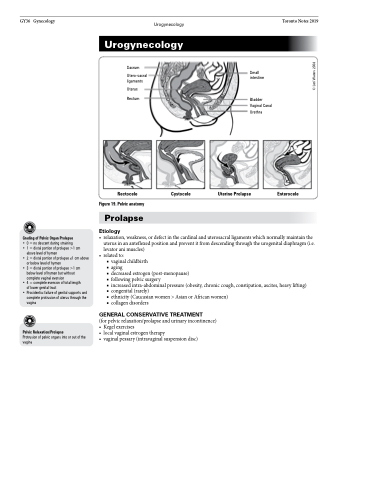Page 522 - TNFlipTest
P. 522
GY36 Gynecology
Urogynecology
Toronto Notes 2019
Urogynecology
Rectocele Figure 19. Pelvic anatomy
Prolapse
Etiology
Cystocele
Uterine Prolapse
Enterocele
Sacrum
Utero-sacral ligaments
Uterus Rectum
Small intestine
Bladder Vaginal Canal Urethra
Grading of Pelvic Organ Prolapse
• 0 = no descent during straining
• 1 = distal portion of prolapse >1 cm
above level of hymen
• 2 = distal portion of prolapse ≤1 cm above
or below level of hymen
• 3 = distal portion of prolapse >1 cm
below level of hymen but without
complete vaginal eversion
• 4 = complete eversion of total length
of lower genital tract
• Procidentia: failure of genital supports and
complete protrusion of uterus through the vagina
Pelvic Relaxation/Prolapse
Protrusion of pelvic organs into or out of the vagina
• relaxation,weakness,ordefectinthecardinalanduterosacralligamentswhichnormallymaintainthe uterus in an anteflexed position and prevent it from descending through the urogenital diaphragm (i.e. levator ani muscles)
• relatedto:
■ vaginal childbirth
■ aging
■ decreased estrogen (post-menopause)
■ following pelvic surgery
■ increased intra-abdominal pressure (obesity, chronic cough, constipation, ascites, heavy lifting) ■ congenital (rarely)
■ ethnicity (Caucasian women > Asian or African women)
■ collagendisorders
GENERAL CONSERVATIVE TREATMENT
(for pelvic relaxation/prolapse and urinary incontinence) • Kegelexercises
• localvaginalestrogentherapy
• vaginalpessary(intravaginalsuspensiondisc)
© Lori Waters 2008


